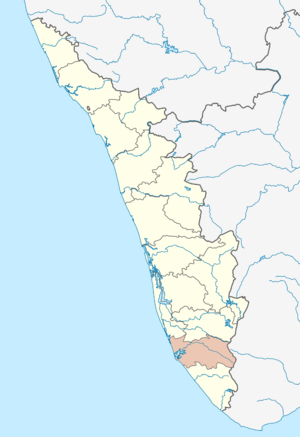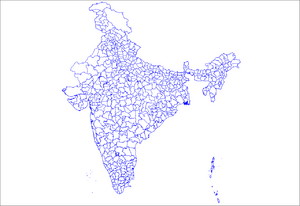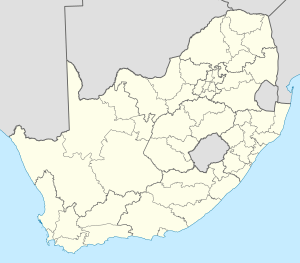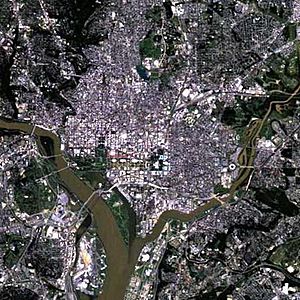District facts for kids
A district is a special area or division within a country or a larger region. Think of it like a neighborhood, but often much bigger, with its own local government or special purpose. Districts can be different sizes, from a small part of a city to a large area covering many towns. They help organize how a country is run and how services are provided to people.
By Country
Afghanistan
In Afghanistan, a district is called a Wuleswali (ولسوالۍ). It's a smaller part of a province. There are almost 400 districts across the country.
Australia
In Australia, districts are used for state elections, helping people choose their representatives. Historically, they were also used to divide land for ownership records.
Austria
In Austria, a district is called a Bezirk. It usually includes several towns and is managed by a local office called the Bezirkshauptmannschaft. This office helps with federal and state laws. The people in charge of these districts are appointed, not elected.
Vienna
Vienna is a special city in Austria. It's divided into 23 districts. These districts have elected representatives who work to help local people with issues like traffic.
Azerbaijan
Azerbaijan also uses districts as a way to divide its land for administrative purposes.
Bangladesh
Bangladesh has 64 districts, which are local administrative units. Each district is further divided into smaller areas called Upazila. This system helps manage the country's local services.
Belgium
In Belgium, some large cities like Antwerp are divided into districts. These districts have their own elected councils to help manage local affairs. Antwerp has nine such districts.
Bhutan
Bhutanese districts are called dzongkhag. They are made up of smaller village blocks called gewog. Some even have subdistricts called dungkhag.
Bosnia and Herzegovina
In Bosnia and Herzegovina, a district is a self-governing area.
Brčko District
The Brčko District is a special self-governing area in northeastern Bosnia and Herzegovina. It's unique because it's formally part of both main parts of the country. It has its own assembly with 29 members.
Brazil
In Brazil, cities are divided into districts. Smaller cities might have just one main district where the city hall is located. Larger cities can have many districts, some of which might have their own sub-offices to help manage local services.
Canada
Alberta
In Alberta, there are "municipal districts" and "improvement districts." These are types of rural areas with their own local governments. They are also used for counting populations by Statistics Canada.
British Columbia
British Columbia has several types of districts:
- District municipalities: These are like towns or cities, but are called "districts." Examples include the "District of Mission."
- Regional districts: These are larger areas, similar to counties, that group together several municipalities and other areas.
- Electoral districts: These are areas where people vote for their representatives.
- Forest districts: These are administrative areas for managing forests.
- Land districts: These are used for land surveys and property records.
- School districts: These manage local schools.
New Brunswick
New Brunswick has many "local service districts" that provide services to rural areas. It also has school districts and electoral districts for voting.
Ontario
In Ontario, districts are special areas of the province, especially in northern parts. Unlike counties, they don't have their own local governments in the same way. They were created to help deliver government services to areas with fewer people.
Northwest Territories
Historically, the federal government created districts in the Northwest Territories between 1870 and 1905. These districts later became separate territories or provinces, like Yukon or Alberta.
Quebec
In Quebec, districts are electoral subdivisions within cities, similar to "wards" in other places. They help organize local elections.
People's Republic of China
China uses districts, called qū, as a way to divide cities. These districts are like a county-level area within a larger city. In ancient China, the term "district" was often used to refer to xian, which is now translated as "county."
Republic of China (Taiwan)
In the Republic of China, a district (Qū) is the third level of administrative division. It's a part of special municipalities and provincial cities. There are 157 districts in Taiwan.
Colombia
In Colombia, a district is a special administrative unit. There are ten such districts, each with a unique purpose. For example, Bogotá is the "Capital District," and Cartagena is a "Tourism and Cultural District."
Czech Republic
In the Czech Republic, a district is called an okres. After a reform in 2002, these districts mostly became statistical areas, with administrative power shifting to larger regions and selected towns.
France
Historically, French districts were the first subdivisions of departments from 1790 to 1800. Later, in the 20th century, districts were a type of inter-community group, which have since been replaced by other forms of local cooperation.
Germany
Germany has districts called Kreis. These are administrative units between the states and local towns. Most are "rural districts" (Landkreise), while large cities (usually over 100,000 people) are "urban districts" (Kreisfreie Städte). Some states also have "government districts" (Regierungsbezirk) as an extra layer of administration.
Hong Kong
Hong Kong is divided into 18 districts, and each has a district council that helps manage local affairs.
Hungary
Hungary has 175 districts, which were created in 2013. The country's 19 counties are divided into these districts. The capital city, Budapest, is also divided into 23 districts.
India
India's districts are local administrative units that came from the time of British rule. They are usually the level of government just below the states and territories. A district is led by a "Deputy Commissioner" or "Collector." This person is in charge of overall administration, keeping law and order, collecting taxes, and handling criminal cases in the district courts. Districts are often divided into smaller units called tehsils or talukas. These units help with things like collecting revenue. Most Indian districts are named after their main town or city. As of April 2016, India had 664 districts.

In some states, like Andhra Pradesh, the administration is further broken down:
- Districts are led by a collector.
- Districts have revenue divisions, led by a Revenue Divisional Officer.
- Revenue divisions are divided into taluks or mandals, led by tahsildars.
- Mandals are made up of villages, managed by village officers.
India also has a system called Panchayati Raj, which involves elected councils at the village, cluster, and district levels to manage local affairs.
Indonesia
In some parts of Indonesia, a "distrik" is a subdivision of a larger area called a regency or a city. This term is similar to kecamatan, which is sometimes translated as "subdistrict." These districts don't have their own legal power but help with administration.
Iran
Iran is divided into provinces, and each province is further divided into "counties" called shahrestan. A shahrestan includes a city center, smaller sections called bakhsh, and many villages. The head of a shahrestan is called a Farmandar, who acts as the governor.
Iraq
In Iraq, districts are called qadaa. There are over a hundred districts, each within one of Iraq's 18 governorates (provinces). Districts are usually named after a city within them, which is often the district's capital.
Japan
In Japan, a district (gun) is a local administrative unit that includes towns and villages, but not cities. While its administrative role was removed in 1923, it's still used for addressing places.
Kenya
In Kenya, a district (wilayah) is a subdivision of a province and is led by a "District Officer."
South Korea
In South Korea, a district (gu) is a subdivision of larger cities. In cities like Seoul, these districts are treated almost like cities themselves.
Mauritius
The Republic of Mauritius is divided into nine districts. These are the second level of administrative divisions after the country's outer islands. The capital city, Port Louis, is located in one of these districts. The island of Rodrigues used to be a district but gained self-governing status in 2002.
Malaysia
In Malaysia, a district is called Daerah. A district directly managed by the federal government is called a "Federal Territory," like Kuala Lumpur. In Peninsular Malaysia, a district is a division of a state. In East Malaysia, a district is a subdivision within a larger division of a state. Each district usually has a "District Office" led by a district officer. Local governments, like District Councils or City Councils, manage these areas. Sometimes, one local government might manage several districts, or a large district might have multiple local governments.
Nauru
The districts of Nauru are the only subdivisions of this small island nation.
Nepal
Nepal is divided into 75 districts. Each district acts as its own administrative unit. Districts contain smaller units like Village Development Committees and Municipalities. Important documents like citizenship cards are issued by the Chief of District Office.
New Zealand
In New Zealand, a district is a type of local government area that is not considered a city. Districts are usually less urbanized, cover more rural land, and have smaller populations than cities. They manage local services and planning. A district might even span across more than one region.
Northern Cyprus
Northern Cyprus is divided into districts for administrative purposes.
Norway
Norway also has districts as administrative divisions.
Pakistan
Pakistan's districts are local administrative units, similar to those in India. They were inherited from British rule. Pakistan has 130 districts, which include villages, towns, and cities. A district used to be led by an elected "district nazim" (mayor) and a district council. However, since 2010, "District Coordination Officers" appointed by the provincial government have taken over these powers.
Peru
Peru uses districts as administrative divisions.
Philippines
In the Philippines, the term "district" has several uses.
Legislative
- National: A "congressional district" is an area that elects a representative to the lower house of Congress. Each state has one or more districts, based on population.
- Regional: Some regions, like the Autonomous Region in Muslim Mindanao, also have legislative districts that elect members to a regional assembly.
- Provincial: Provinces have "provincial districts" for electing members to the Provincial Council.
- City: Cities have "city councilor districts" for electing members to the City Council.
Administrative
Some cities, like Manila, divide their areas into city districts for administrative purposes, though their powers can vary. Historically, districts were used as the lowest level of government before the creation of barangays (villages).
Special-purpose districts
There are also special districts created for specific government departments, like school districts for education or engineering districts for public works.
Informal districts
Sometimes, cities use the word "district" informally to refer to certain areas, like a "central business district," even if they don't have formal administrative powers.
Poland
In Poland, the second level of local government is called a powiat, which is similar to a county or district. As of 2008, Poland had 379 such entities.
Portugal
Districts (distritos) in Portugal were administrative divisions mainly used for civil governors. While the role of civil governor has changed, district areas are still used by some public and private organizations, like the police or football associations.
Russia
In Russia, districts are called raions. They are administrative divisions within larger regions or cities. In the Sakha Republic, districts are called ulus, which means the same thing. Historically, the term "district" was used for uyezds in the Russian Empire.
Serbia
Serbia is divided into 29 districts (okrug), plus the city of Belgrade. Each district is further divided into municipalities.
Slovakia
In Slovakia, a district (okres) is a local administrative unit.
South Africa
In South Africa, a "district municipality" is a level of government below the provinces. A district municipality is then divided into several "local municipalities." However, in the eight largest urban areas, a "metropolitan municipality" replaces both the district and local municipality levels. Examples include Cape Town and Johannesburg.
Sri Lanka
For local government, Sri Lanka is divided into nine provinces, which are then divided into districts. Each district is further divided into "Divisions," which are administered by a "Divisional Secretary." Rural Divisions also have elected councils called Pradeshiya Sabha.
Sweden
Some cities in Sweden divide their territory into smaller areas, often called "districts" in English. These areas might have administrative boards responsible for certain local government tasks.
Switzerland
In Switzerland, some cantons (states) organize themselves into districts, while others manage directly at the electoral district level.
Thailand
In Thailand, a district (amphoe) is a subdivision of a province. Some provinces also have smaller "minor districts."
Turkey
In Turkey, a district (ilçe) is an administrative subdivision of a province (il).
United Kingdom
England
England uses districts as a common form of local government. In areas with two-tier local government, districts are the lower tier, below counties. Districts are responsible for things like:
- Collecting local taxes (council tax)
- Leisure services
- Garbage collection
- Housing
- Planning
- Arts and entertainment
- Environmental health
Each district collects taxes from residents to fund its own services and contribute to the upper-tier authority.
Wales
In Wales, the word "district" is not officially used. The country is divided into 22 "unitary authorities" that handle all local government functions.
Scotland
Districts were local government areas in Scotland between 1975 and 1996. Before that, from 1930 to 1975, they were subdivisions of counties. Since 1996, Scotland has been divided into 32 "unitary council areas," and districts are no longer used.
Northern Ireland
Northern Ireland is divided into 26 districts for local government. These councils have different responsibilities than those in the rest of the UK. They handle things like waste and recycling, leisure services, building control, and local economic development. They do not manage education or road building.
Ukraine
In Ukraine, districts (raions) are the second level of administrative division. They are the most common way to divide Ukrainian regions and are also used as administrative divisions within larger cities.
United States
The United States has several types of districts:
- Congressional districts: These are areas that elect a representative to the U.S. Congress. Each state has one or more, based on its population. There are 435 congressional districts in total, each with about 630,000 people.
- Legislative districts: These elect representatives to state legislatures.
- Federal judicial districts: These are areas where federal courts have authority.
The District of Columbia is a special area that is not part of any state. It is the capital of the United States.
The U.S. also has many "special-purpose districts" that have limited local government powers. The most common are "school districts," which manage local schools. Other types include community college districts, hospital districts, and public transit districts.
Many cities also use "non-governmental districts" to identify specific areas or neighborhoods, like Hollywood in Los Angeles. These districts are still part of the main city and follow its laws.
Various agencies also recognize "historic districts" to protect important historical areas.
Vietnam
In Vietnam, the term "district" refers to the second level administrative unit, below provinces and centrally administered cities. In rural areas, this unit is called a "huyện," while in urban areas, they are "quận" (urban sub-divisions), "Thành phố trực thuộc tỉnh" (provincial cities), or "thị xã" (towns). As of 2011, Vietnam had 698 "districts" of various types. Vietnamese districts can vary greatly in population and size.
See also
 In Spanish: Distrito para niños
In Spanish: Distrito para niños




